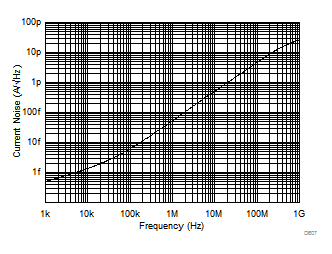ZHCSI18A April 2018 – July 2018 OPA858
PRODUCTION DATA.
9.3.5 Current Noise
The input impedance of CMOS and JFET input amplifiers at low frequencies exceed several GΩs. However, at higher frequencies, the transistors parasitic capacitance to the drain, source, and substrate reduces the impedance. The high impedance at low frequencies eliminates any bias current and the associated shot noise. At higher frequencies, the input current noise increases (see Figure 53) as a result of capacitive coupling between the CMOS gate oxide and the underlying transistor channel. This phenomenon is a natural artifact of the construction of the transistor and is unavoidable.
 Figure 53. Input Current Noise (IBN and IBI) vs Frequency
Figure 53. Input Current Noise (IBN and IBI) vs Frequency